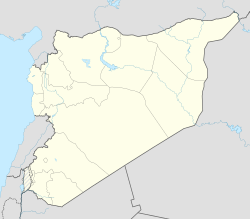Syria and weapons of mass destruction
| Syria | |
|---|---|
| Nuclear program start date | 1979 |
| First nuclear weapon test | None |
| First fusion weapon test | None |
| Last nuclear test | None |
| Largest yield test | None |
| Total tests | None |
| Peak stockpile | None |
| Current stockpile | None |
| Maximum missile range | Scud-D (700km) |
| NPT signatory | Yes |
Syria and weapons of mass destruction deals with the research, manufacture, stockpiling and allegedly use by Syria of weapons of mass destruction, which include chemical weapons and nuclear weapons.
On 14 September 2013, the United States and Russia announced an agreement for the elimination of Syria's chemical weapon stockpiles by June 2014. In October 2013, the OPCW-UN Joint Mission destroyed all of Syria's declared chemical weapons manufacturing and mixing equipment. Several months later, Syria disclosed that it maintained a ricin chemical weapons program, which the Syrian government claims has fallen into the hands of Syrian Opposition forces in the east of the country. The following month Syria, further disclosed that it had 4 more previously hidden chemical weapons production sites. The Israeli intelligence community believes the Syrian government retains several tons of chemical weapons.
The Syria file at the International Atomic Energy Agency (IAEA) remains open, amid Syria's failure to respond to the IAEA's questions about a facility, destroyed in 2007 by Israel, that the IAEA concluded was "very likely" a nuclear reactor, including the whereabouts of the reactor's nuclear fuel. In January 2015, it was reported that the Syrian government is suspected to be building a nuclear plant in Al-Qusayr, Syria, allegedly with the aim of developing nuclear weapons.
Following the Israeli occupation of the Golan Heights during the 1967 Six-Day War, and South Lebanon in 1978, the Syrian government has regarded Israeli military power as a threat to Syrian security. Syria first acquired chemical weapons from Egypt in 1973 as a military deterrent against Israel before launching the Yom Kippur War. Despite the fact that Syrian officials did not explicitly declare the chemical weapons capability, they implied it through speeches and in addition warned of retaliations. Internal Syrian chemical weapons capability may have been developed alongside indirect Russian, German, Chinese and Indian technical and logistical support.
...
Wikipedia

